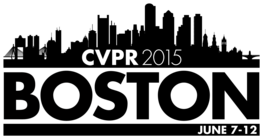-
Toward User-Specific Tracking by Detection of Human Shapes in Multi-Cameras
AbstractHuman shape tracking consists in fitting a template model to temporal sequences of visual observations. It usually comprises an association step, that finds correspondences between the model and the input data, and a deformation step, that fits the model to the observations given correspondences. Most current approaches find their common ground with the Iterative-Closest-Point (ICP) algorithm, which facilitates the association step with local distance considerations. It fails when large deformations occur, and errors in the association tend to propagate over time. In this paper, we propose a discriminative alternative for the association, that leverages random forests to infer correspondences in one shot. It allows for large deformations and prevents tracking errors from accumulating. The approach is successfully integrated to a surface tracking framework that recovers human shapes and poses jointly. When combined with ICP, this discriminative association proves to yield better accuracy in registration, more stability when tracking over time, and faster convergence. Evaluations on existing datasets demonstrate the benefits with respect to the state-of-the-art.
Related Material
[pdf][bibtex]@InProceedings{Huang_2015_CVPR,
author = {Huang, Chun-Hao and Boyer, Edmond and do Canto Angonese, Bibiana and Navab, Nassir and Ilic, Slobodan},
title = {Toward User-Specific Tracking by Detection of Human Shapes in Multi-Cameras},
booktitle = {Proceedings of the IEEE Conference on Computer Vision and Pattern Recognition (CVPR)},
month = {June},
year = {2015}
}
CVPR 2015 open access
These CVPR 2015 papers are the Open Access versions, provided by the Computer Vision Foundation.
Except for the watermark, they are identical to the accepted versions; the final published version of the proceedings is available on IEEE Xplore.
Except for the watermark, they are identical to the accepted versions; the final published version of the proceedings is available on IEEE Xplore.
This material is presented to ensure timely dissemination of scholarly and technical work.
Copyright and all rights therein are retained by authors or by other copyright holders.
All persons copying this information are expected to adhere to the terms and constraints invoked by each author's copyright.

